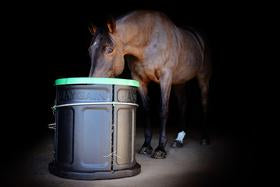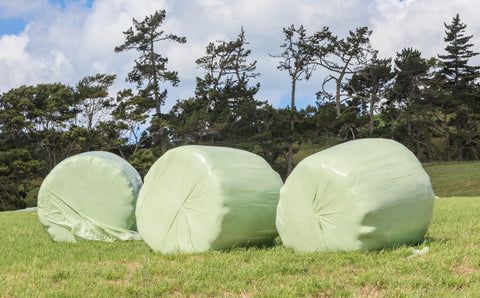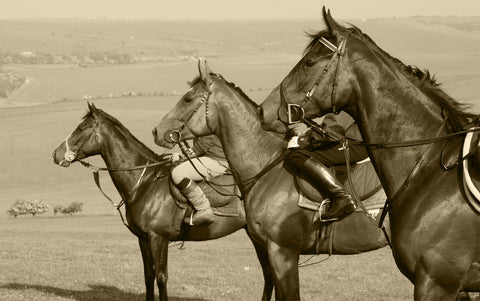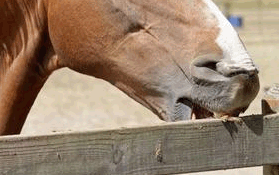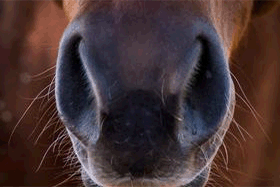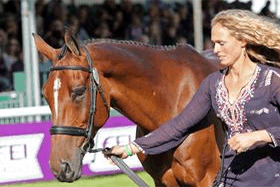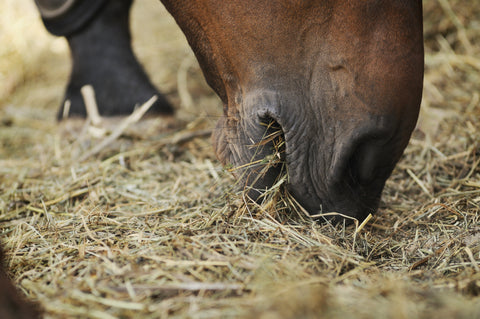The nutritional benefits of slow feeding
Would you run a personal best time with a stomach ache? Gastric ulceration is the reality for 70 – 90% racehorses in training and 75% of event horses [1]. The problem is so widespread, it seems to level the playing field, so few notice the performance problems. Ulceration occurs when the stomach lining is damaged. When scoped, most ulcers are found the upper part of the stomach, which isn’t designed to withstand the constant production of hydrochloric acid. Gastric ulcers are known to be associated with stress and routinely spending more than 4 hours without feed. Impaction colic occurs when the gut movements slow down during fasting. The answer is to increase the time it takes to eat a quantity of feed, known as ‘slow feeding’. It is most often used to help fat ponies lose weight - but competition horses would also clearly benefit.
The benefits of ‘slow-feeding’ forage start even before the horse has swallowed a mouthful. It starts with the ‘chew’. Chewing obviously breaks the feed into smaller particles, but this action also releases soluble matter from the feed, such as sugars, for ease of digestion. Horses only produce saliva when they chew – not like Pavlov’s dogs in anticipation of food. Chewing hay generates at least twice as much saliva as chewing concentrate [2] to buffer stomach acid [3].
The swallowed forage also forms a protective ‘mat’ in the stomach, stopping acid splashing up and damaging the upper part of the stomach. The longer a horse goes without food, the more of this protective mat is digested away, until there is none. As a double-jeopardy, when they are finally presented with feed, initial intake rates have been measured at around 15x faster than normal [4]. The resulting stretched full stomach then stimulates the production of even more acid, and forage isn’t chewed sufficiently.
At high intake rates, food spends less time in the stomach and enters the small intestine. If not properly chewed, forage could cause impaction colic. If concentrates are eaten without much chewing, the carbohydrates may not have been adequately released. They could end up in the hind-gut, risking gas colic or laminitis.
So how can we slow our horses down? For forage feeds, a standard haynet only increases feeding time over loose-fed systems by a third, while small-holed haynets showed only a weak trend to extend intake time over large-holed haynets by only about 5 minutes per kg. When a ration was fed in early evening, not only were all the nets finished before midnight, horses were found to have eaten wood shavings from their bedding [5]. Trials involving doubled or triple-layer small holed haynets hung in multiple locations in the stable extended overall eating time by 2 hours [6] (= 1.30am). Unfortunately, horses performed between 33% and 83% more crib-bites when eating from multiple layered hay nets than a single net. Fortunately, the new Haygain Forager has been found to double the length of time it takes to eat loose hay [7], without the stress of multiple haynets, and with behavioural and respiratory benefits not possible with either methods.
As for concentrates, it is advised that a maximum of 1g starch per 1kg of bodyweight be fed as a maximum per meal (eg. 500g starch per meal for a 500kg horse), meaning lots of meals a day if feeding grain. Alternatively, corn oil can be used to reduce the amount of grain fed. It is a great source of essential fatty acids, is more than twice as calorific as any protein or carbohydrate, and can be steadily increased in the diet up to 1ml oil per kg bodyweight per day. This also means the horse has more appetite for forage.
[1] Rabuffo, T. S., Hackett, E. S., Grenager, N., Boston, R., & Orsini, J. A. (2009). Prevalence of gastric ulcerations in horses with colic. Journal of Equine Veterinary Science, 29(6), 540-546. [2] Ellis, A. D. (2010). Biological basis of behaviour in relation to nutrition and feed intake in horses. The Impact of Nutrition on the Health and Welfare of Horses, (128), 53. [3] Merritt, A.M., Vulliand, V. (2013) Gastrointestinal physiology (1)5 in Geor, R.J., Harris, P.A., and Coenen, M. (Eds) Equine Applied and Clinical Nutrition Health, Welfare and Performance, Elsevier Ltd. [4] Fleurance, G., Fritz, H., Duncan, P., Gordon, I. J., Edouard, N., & Vial, C. (2009). Instantaneous intake rate in horses of different body sizes: influence of sward biomass and fibrousness. Applied Animal Behaviour Science, 117(1), 84-92. [5] Ellis, A. D., Fell, M., Luck, K., Gill, L., Owen, H., Briars, H., ... & Harris, P. (2015). Effect of forage presentation on feed intake behaviour in stabled horses. Applied Animal Behaviour Science, 165, 88-94. [6] Ellis, A. D., Redgate, S., Zinchenko, S., Owen, H., Barfoot, C., & Harris, P. (2015). The effect of presenting forage in multi-layered haynets and at multiple sites on night time budgets of stabled horses. Applied Animal Behaviour Science, 171, 108-116. [7] Pickup L. (2017) Efficacy of a novel slow feeding system on intake rate and behaviour in normal and hyper reactive stabled horses. [video of Powerpoint presentation by author] Retrieved from personal files.

